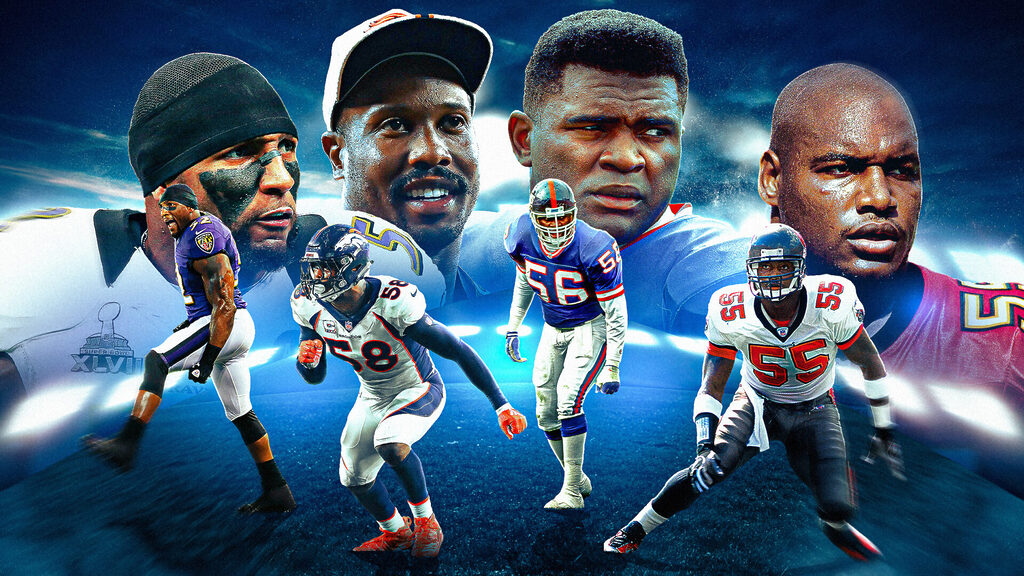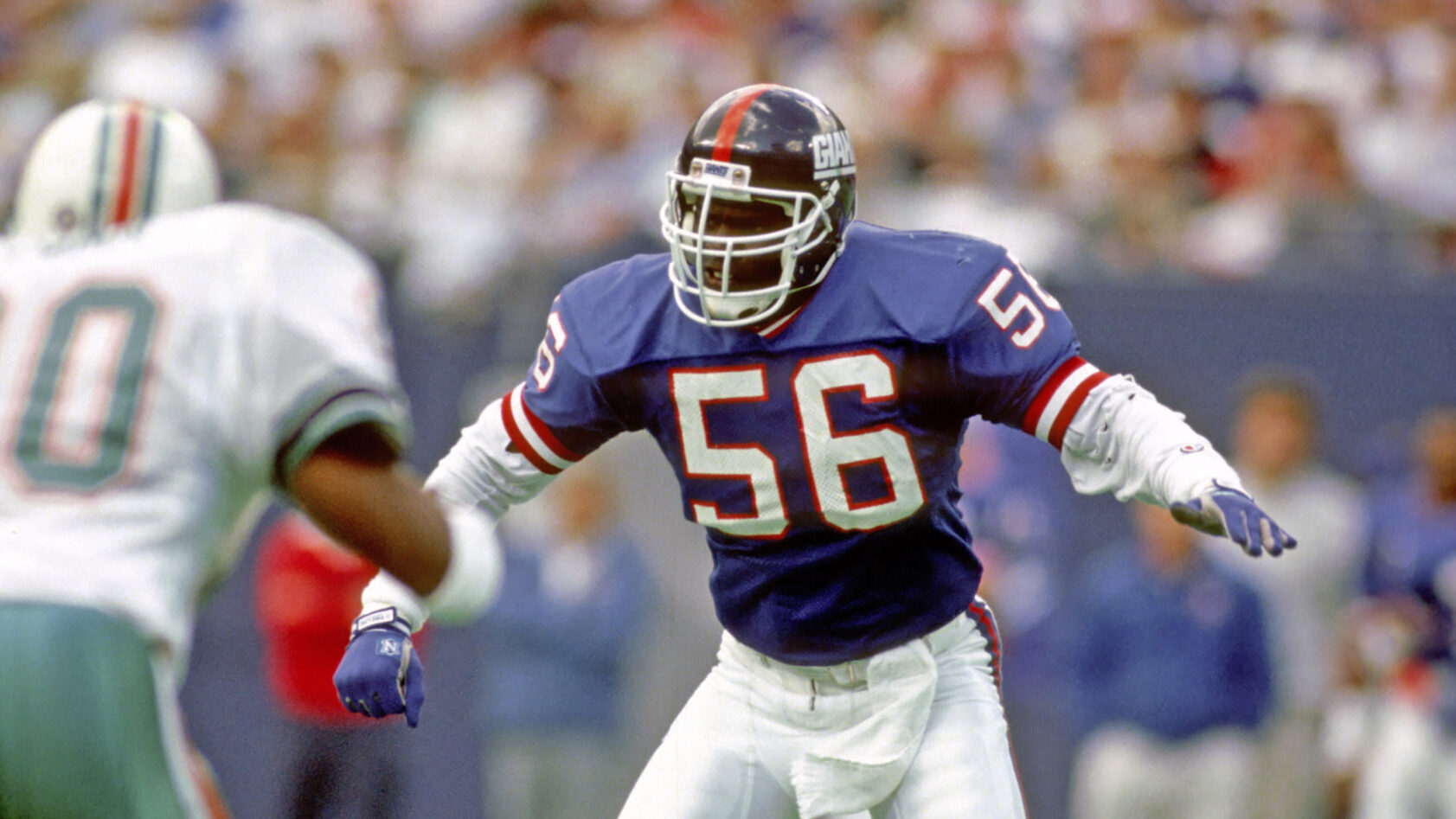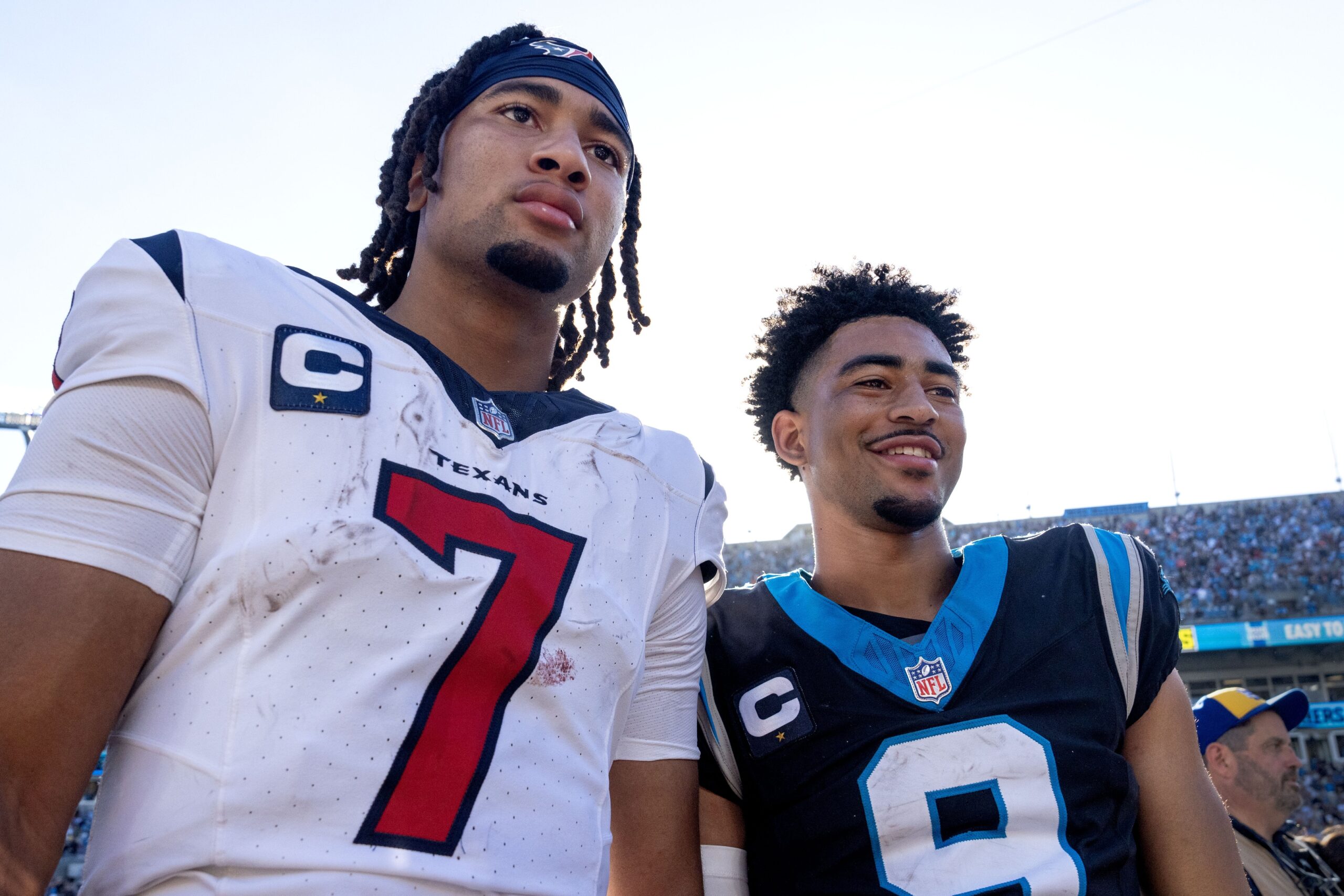Analysis
7/17/23
11 min read
Ranking NFL's Top 11 Linebackers of All Time

Linebackers come in all shapes and sizes. Two of my favorite linebackers (and two of the best all-time) are 5-foot-9 Sam Mills and 6-foot-7 Ted Hendricks.
How do we pick just the greatest 11? After all, there are about three dozen linebackers in the Pro Football Hall of Fame, plus so many terrific active linebackers (Micah Parsons and Matt Milano) and recently retired ones.
The best of the best were impact players on great defensive teams with many accolades (Pro Bowls, All-Pro appearances, MVPs).
READ: All-Time QB Rankings | All-Time WR Rankings
Best LBs in NFL History
11. Chuck Bednarik
Accolades: 6-time All-Pro, 8-time Pro Bowl, 2-time NFC champion (1949, 1960).
This World War II veteran played for the Philadelphia Eagles between 1949-1962. If sports fans appreciate what Shohei Ohtani is doing in baseball, Bednarik should be equally respected.
He was the NFL’s last full-time two-way player as a center and linebacker. His nickname was the “Sixty-Minute Man” for a reason: he was every bit the unicorn in 1960 that Ohtani is today.
His most famous hit was a blindside shot that put New York Giants Hall of Famer Frank Gifford out of football for a year. The date was Nov. 20, 1960, and Philadelphia played in New York in a huge game for both teams.
Late in the game, Gifford cut across the middle from the left and made a reception, trying to get out of bounds to stop the clock when he was hit low by defensive back Don Burrough and high by Bednarik.
Gifford landed hard on the back of his head, was knocked unconscious and fumbled. The Eagles recovered the fumble and clinched the victory. As Gifford lay motionless, Bednarik stood over him, shaking his fist and dancing.
Bednarik was celebrating the win, not the injury, and would later send Gifford a basket of fruit delivered to his hospital room.
The linebacker likened the tackle to “a truck hitting a sports car.” It defines the position.
10. Derrick Brooks
Accolades: 9-time All-Pro, 11-time Pro Bowl, DPOY in 2002, Super Bowl champ
They called Bednarik the “Sixty-Minute Man,” but they should have called Derrick Brooks the “16-game season”. Brooks played 224 games in only 14 seasons — meaning he played every game possible in his career.
Brooks didn’t just have the durability and longevity going for him. His peak was extraordinarily high. He was named the NFL’s Defensive Player of the Year in 2002 when he led the Tampa Bay Buccaneers with 118 tackles, registered a career-high five interceptions (three were returned for TDs), 15 passes defended, one fumble recovery and one sack.
He was a major contributor to the Buccaneers’ victory in Super Bowl XXXVII. Brooks had three tackles, one pass defended, and one interception returned 44 yards for a touchdown against the Raiders.
9. Von Miller
Accolades: 8-time Pro Bowl, 7-time All-Pro, SB champ twice (50, LVI).
Von Miller hasn’t just been along for the ride on two Super Bowl champions. He was instrumental in the Denver Broncos and Los Angeles Rams' titles.
In Super Bowl 50 against the Carolina Panthers, he was the Super Bowl MVP with 2.5 sacks and two quarterback hits. He also forced two fumbles. Six years later, with the Rams, he had two sacks and two tackles-for-loss against the Cincinnati Bengals.
In 11 postseason games, Miller has 10.5 sacks, 12 tackle-for-loss and 18 quarterback hits. If Miller hadn’t suffered an ACL injury last year, would he have led Buffalo to a Super Bowl? Who knows?
What else puts Miller on the list of all-time greats? He had dominant seasons when he started at inside linebacker (finishing second to J.J. Watt for DPOY in 2012). He also has other dominant seasons when he started at outside linebacker.
8. Jack Ham
Accolades: 8-time Pro Bowl, 6-time All-Pro, 4-time Super Bowl champion
There are only 11 spots on this list, and it’s impossible not to include two members of the Pittsburgh Steelers' dynasty that won four Super Bowls in six years. The middle linebacker from that team will be listed ahead of Jack Ham, but that’s not to belittle Ham’s contributions.
Pittsburgh doesn’t beat the 12-2 Raiders in the 1974 AFC Championship Game without Ham. Oakland led 10-3 early in the fourth quarter. Ham’s second interception of Ken Stabler in the game was returned to the Raiders' 9-yard line to set up the Steelers’ go-ahead touchdown.
It’s impossible to relate to young fans today how good the Steelers' defense was. In the final nine games of the 1976 season, they ran the table, winning nine straight games.
The Steelers gave up 28 points in the nine games (6, 0,0, 0, 3, 16, 3, 0,0). That’s just more than three points per game. They had five shutouts, allowing only two touchdowns. They forced 28 turnovers in that stretch.
7. Jack Lambert
Accolades: 9-time Pro Bowl, 7-time All-Pro, 4-time Super Bowl champion
Jack Lambert was the NFL Defensive Rookie of the Year in 1974. He was All-Pro eight times in nine years (1975-1983) and played in nine straight Pro Bowls. That’s virtually his entire career, as he was forced to retire in 1984 after a severe toe injury.
He was Defensive Player of the Year in 1976 (and finished second to quarterback Bert Jones in MVP voting) and was his team’s defensive captain for eight years.
He was a great cover linebacker and deserves a spot among the greatest ever to play the position.
6. Ted Hendricks
Accolades: 8-time Pro Bowl, 6-time All-Pro, 4-time Super Bowl champion
Why is Ted Hendricks ranked ahead of Ham and Lambert (besides the fact I’m a lifelong Raiders fan)? Well, Hendricks won just as many Super Bowls (four) and lasted longer. He played 15 years for the Indianapolis Colts, Green Bay Packers and Raiders between 1969-1983.
He made his first Pro Bowl at 24 in 1971 and his last in 1983 at 36. In 1974, with Green Bay, he finished third in Defensive Player of the Year voting. All he did was intercept five passes, block seven kicks and score a safety.
In 1980 and 1982, he finished second in DPOY with the Raiders.
Hendricks played in 215 consecutive regular-season games and participated in seven AFC Championship Games and four Super Bowls (V with the Colts, XI, XV, XVIII with the Raiders).
Hendricks didn’t just play in four Super Bowls. His teams won all four games by a combined score of 113-46. He played in 21 playoff games. His teams were 17-4.
He was an individual in a team sport, a maverick perfect for the Raiders in that time and that place. Hendricks belongs where he is ranked, behind the top five linebackers of all time.
5. Mike Singletary
Accolades: 10-time Pro Bowl, 8-time All-Pro, Super Bowl XX champion
In 1985 and 1988, he won Defensive Player of the Year. He was a big part of the Chicago Bears’ Super Bowl championship; he recovered a pair of fumbles in the 46-10 victory. Rodney Harrison told me Mike Singletary had the instincts, leadership and toughness Ray Lewis and Junior Seau would later display.
“They were like the same player. I loved Mike Singletary,” said Harrison, who grew up in Chicago watching the 1985 Bears. This spot is recognized for his role on one of the great defenses of all time.
Da’ Bears Defense:
| Year | PPG Allowed |
| 1984 | 15.5 |
| 1985 | 12.4 |
| 1986 | 11.7 |
| 1987* | 18.7 |
| 1988 | 13.4 |
*1987 was a strike-shortened season with 15 games, three of them being replacement games which skewed things.
He was an all-time player on an all-time defense.
4. Dick Butkus
Accolades: 8-time Pro Bowl, 6-time All-Pro
Remember what I said about the all-time linebackers having to perform in big games for great teams? That all goes out the window with Butkus, the greatest middle linebacker of the 1960s.
In 1969, his Bears finished 1-13. Butkus placed sixth in the MVP voting. He was a top-five finisher in MVP in 1967 (7-6-1), 1968 (7-7) and 1970 (6-8).
What hurt him was medical advancement. He suffered a serious knee injury in 1970, at 28, and was basically finished. If he had been born a decade or two later, he would have had the longevity that some of the other great linebackers had.
3. Junior Seau
Accolades: 12-time Pro Bowl, 6-time All-Pro
What hurt him was medical advancement. He played 268 games in a 20-year career (Butkus played 119 games in an 8½-year career). Butkus is still with us more than 50 years after he was forced to retire.
Seau is gone, ending his life in 2012 at 43, just three years after his final NFL game. Seau had chronic traumatic encephalopathy (CTE), believed to be caused by repetitive head trauma.
In my objective brain, the two linebackers ranked above Seau were the best. Ray Lewis is the greatest inside linebacker. Lawrence Taylor is the greatest outside linebacker. My subjective eyes tell a different tale, in which Seau is the best linebacker of all time.
I saw Seau play the AFC Championship Game after the 1994 season. Seau’s Chargers were on the road in Pittsburgh, and he was playing with a pinched nerve in his neck that deadened his left arm.
He played with one good arm and was brilliant despite aggravating his injury in the second quarter. Seau was instrumental in stopping the Steelers’ No. 1 rushing attack from doing any damage. He was brilliant dropping into coverage. Seau had 16 tackles, including a stop in the final 90 seconds on the 3-yard line that vaulted his Chargers into the Super Bowl.
Norv Turner said he never took a down off in practice. Harrison told me he has been around so many greats but has never seen a work ethic like Seau’s.
He played WILL (weak inside linebacker). Unless he saw something at the line of scrimmage and told a teammate to switch, he didn’t do those things to pad his stats. He did it because he was a student of the game.
He did it all for about as long as humanly possible — maybe too long. When his speed and explosiveness diminished, he made up for it with his presence and leadership.
2. Ray Lewis
Accolades: 12-time Pro Bowl, 10-time All-Pro, Super Bowl XXXV MVP
Ray Lewis entered the NFL in 1996, six years after Seau. “I saw Junior when I saw Ray play,” Harrison told me. Lewis looked up to Seau and took different aspects of his game.
By the end of the 1990s, Lewis was the best linebacker in the game. He was a force who made so many bone-crushing hits.
In 2000, Lewis led the Baltimore Ravens' defense to a 16-game single-season record for the fewest points allowed (165) and the fewest yards rushing allowed (970). The Ravens also recorded four shutouts.
Here’s the game in Lewis’s career I remember best.
It was Week 13 of the 2007 season in early December in Baltimore. It was the season Tom Brady and the New England Patriots were 16-0. They came into Baltimore 11-0, scoring 442 points (40.1 ppg). Brady had completed 72.4 percent of his passes, with a 39:4 touchdown to interception ratio.
I’ll never forget getting chills just watching the Baltimore defense — ending with Lewis — being introduced before the game. Although the Patriots won, 27-24, it was a struggle. Brady completed only 18 of 38 (47 percent) passes and was sacked three times.
I felt then, and now, it was like watching the greatest offensive player matched up in a cat-and-mouse game with the greatest defensive player. Lewis recently said studying Brady and Peyton Manning made him a better player. It showed. It was a privilege to watch Lewis play.

1. Lawrence Taylor
Accolades: 10-time Pro Bowl, 8-time All-Pro, 2-time Super Bowl champion
In his last two seasons, Taylor was a shell of himself after a torn Achilles tendon and a hamstring injury. He might have played only in passing downs.
But for the first 11 years (1981-91), he was the best player on the field. He was a game-changer in so many ways.
Part of me wants linebackers to be great, not only moving forward (rushing the quarterback) but moving backward (playing in coverage). That wasn’t Taylor, but again, all rules go out the window for him.
Teams didn’t like to run on him because he shed tacklers so well. They usually ran away from him. Few teams ran successfully on the Giants in the mid-1980s. As a pass rusher, he was the best. He could telegraph he was coming, and teams couldn’t stop him.
He was the league MVP in 1986 when the Giants won the Super Bowl. Taylor transformed the game. It was the perfect group of Taylor’s athleticism, a brilliant set of linebacking teammates and head coach Bill Parcells.
Elliott Kalb has been known in the sports television industry as "Mr. Stats" for more than 35 years. He is a 13-time Sports Emmy winner as a writer, researcher and producer. Follow him on Twitter @MrStats50.










